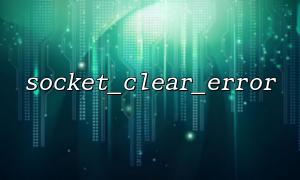When programming sockets in PHP, debugging and error handling are key links to ensure program robustness. Although the socket_clear_error() function is not a function that comes with the PHP standard library, we can clear the previous socket error state through custom or similar mechanisms. Calling the socket_clear_error() function before each socket operation is performed is a widely recommended good programming habit. This article will explain in detail the reasons and the positive impact on debugging and code robustness.
The main function of the socket_clear_error() function is to clear the previous error state before executing a new socket operation to avoid the impact of legacy errors on the current operation. In PHP, socket error status is often obtained by calling socket_last_error() . If the error is not cleared, the old error message may mislead the developer, making it difficult to determine whether the current operation is successful.
We can customize a simple socket_clear_error() function, as follows:
function socket_clear_error($socket) {
// By calling socket_last_error() Read and clear the error status
socket_clear_error_internal($socket);
}
function socket_clear_error_internal($socket) {
// Read the error code to clear the error status
socket_last_error($socket);
}
Note: When using it, you only need to call socket_last_error($socket) to clear the error.
If the error status is not cleaned first, the previously unprocessed error may affect the judgment of this operation. For example, if the last operation failed but the error was not cleared, socket_last_error() may return the old error code even if the next operation is successful, causing the mistakenly to think that the new operation failed.
After cleaning up the error, if the new socket operation fails, the error code returned by calling socket_last_error() must be an error caused by the current operation. This greatly shortens debugging time and improves the accuracy of problem positioning.
Clearing the error status in advance can prevent the program from entering the exception processing process due to misjudgment, thereby reducing the chain reaction caused by error propagation and enhancing program stability.
The following example demonstrates how to clear errors before socket read and write operations to ensure that the error message is accurate and reliable:
<?php
// Create a socket connect
$socket = socket_create(AF_INET, SOCK_STREAM, SOL_TCP);
if ($socket === false) {
echo "create socket fail: " . socket_strerror(socket_last_error()) . "\n";
exit;
}
// connect到服务器
socket_clear_error($socket); // Clear the previous error status
if (!socket_connect($socket, "m66.net", 80)) {
echo "connectfail: " . socket_strerror(socket_last_error($socket)) . "\n";
socket_close($socket);
exit;
}
// send HTTP ask
socket_clear_error($socket);
$request = "GET / HTTP/1.1\r\nHost: m66.net\r\nConnection: Close\r\n\r\n";
if (!socket_write($socket, $request, strlen($request))) {
echo "sendaskfail: " . socket_strerror(socket_last_error($socket)) . "\n";
socket_close($socket);
exit;
}
// Read the response
socket_clear_error($socket);
$response = '';
while ($out = socket_read($socket, 2048)) {
$response .= $out;
}
echo "Response content:\n" . $response;
socket_close($socket);
?>
In the above code, socket_clear_error($socket) will be called before socket_connect , socket_write , and socket_read operations to clear the error to ensure that any error information accurately reflects the status of the current operation.
In PHP socket programming, calling socket_clear_error() before each socket operation is a simple but very effective habit. It can:
Clear old errors and avoid misjudgment;
Helps quickly locate current errors;
Improve the robustness and stability of the code.
This not only reduces the difficulty of debugging, but also makes your code more reliable when facing complex network environments, and is worthy of development by every developer.














